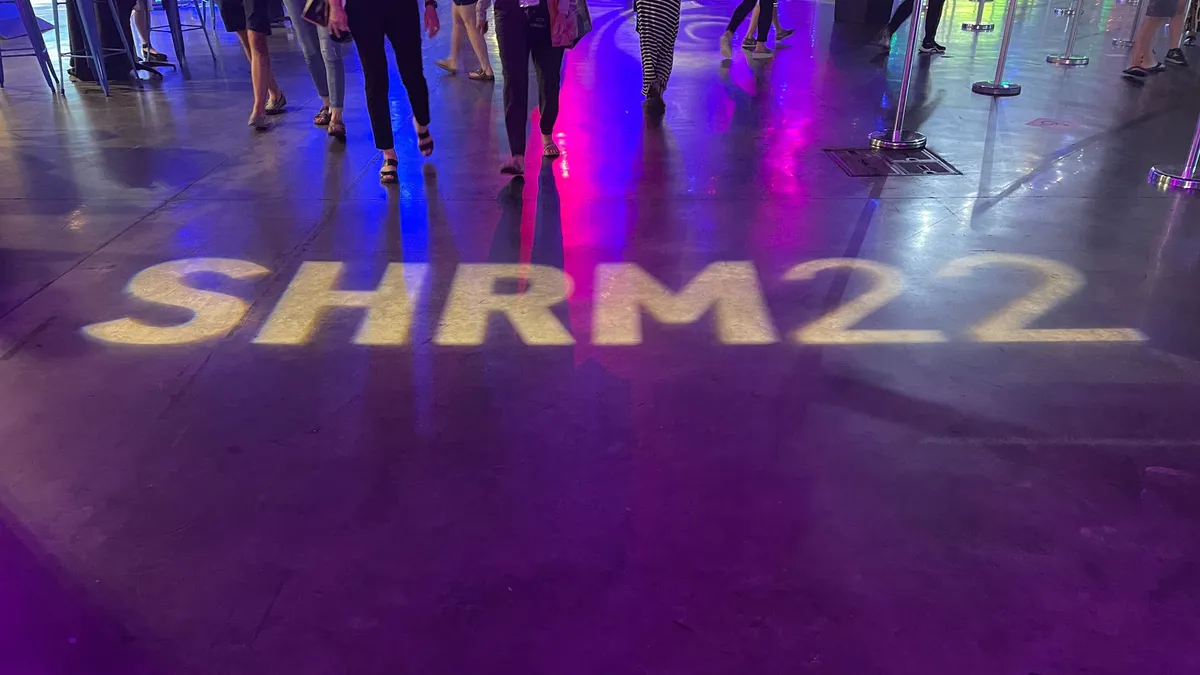NEW ORLEANS – The Society for Human Resources Management’s 2022 conference, currently taking place in New Orleans and virtually, is making one point clear: Employees have full, complex lives, and they need to be treated as such.
Mental health is on everyone’s mind. DEI is no longer a siloed category or a box to check, but integrated into every aspect of HR. Workers care about the world outside, and they want their employers to care, too. People can work in different places, at different times and in different ways, and their employers are taking notice.
Following are a few more takeaways from day one of SHRM’s live conference and expo.
Leaders are key to driving engagement
While HR may have always believed it, the idea that people are an organization’s most important asset is resonating outside the department and throughout the whole organization now, Kris Erickson of Workforce Science Associates said in her presentation. Talent retention has become a top priority for the whole C-suite.
Why did employee engagement go up during the early days of the pandemic? Like in prior crises, people tend to revert to the lowest rungs of Maslow’s Hierarchy of Needs, looking for safety and security, Erickson said. Especially during the major job cuts that hit during spring 2020, many were simply grateful to be employed.
But as the pandemic wore on, employee engagement dropped sharply — down below pre-pandemic levels. According to Erickson, this drop can be attributed in many ways to a failure of leadership.
In a survey of millions of workers across more than 20 industries, WSA found that the single leading factor driving engagement was a company’s future vision. No. 3 was trust in leadership. Other factors that scored high were employee recognition and the potential for growth and development.
Employees want to know their leaders can “right the ship” no matter what happens, Erickson said. They want “open, honest, two-way communication” between leaders and the full slate of employees. And they want a clear-eyed sense of the company’s purpose and value. “People want to work for a cause, not a company,” Erickson said.
Diversity, equity, inclusion and belonging have jumped into the Top 10 factors driving employee engagement for the first time. Among these, Erickson gave special attention to belonging, which she described as the psychological safety to participate in the conversation — a step beyond achieving representation (diversity) and making workers feel welcome (inclusion).
“If belonging wins out, what drives belonging?” Erickson asked. Here, her data showed, it’s about the individual: individual recognition, attention to employee growth and development, two-way communication and a feeling of support during turbulent times.
The bottom line: People want to be seen for who they are, and they want the workplace to be a community they can be proud to belong to.
Employers need to ‘think differently’ on parental benefits
Providing satisfying employee benefits for parents goes far beyond the standard few weeks of maternity leave, according to a panel led by multigenerational work expert Lindsey Pollak and featuring Raina Sorgenti, associate director of Absence Management Programs at Yale University, and Shauna Murphy Cour, vice president of employer solutions at Ovia Health.
First, Cour said, parental leave needs to be longer than a few weeks — or employees will head for the door. While leadership may balk at 3-6 months of leave, they’re not looking at the big picture, she said. Financially, turnover typically costs the organization far more than a longer leave of absence. In addition, what the company gains in gratitude from providing a longer leave may provide another benefit in terms of future engagement and productivity, multiple panelists noted. Employers need to “think differently,” Cour said.
Beyond parental leave, parents and caregivers want flexibility. Sorgenti described the personal benefits she saw from adopting a remote work schedule and cutting out a commute — from not rushing in the morning to being able to cook dinner again. These are “opportunities to connect with family,” she said.
Panelists hit one note benefits experts hear again and again: communication is essential. HR pros can have monthly workplace spotlights on different benefits and make sure resources are easily accessible and easy to navigate, Cour suggested. Sorgenti recommended proactively reaching out to people with benefits resources during qualifying life events.
Panelists also emphasized the importance of listening to employees and connecting with employee resource groups. Benefits resources should use inclusive language and imagery, they said, so employees better understand how they can be used.
Overall, parents need to feel welcome as their full, parental selves in the workplace, panelists said. Managers should know the names of their direct reports’ children; not doing so communicates a total lack of caring about employees as people, Cour said.
Even difficult employees can benefit from clarity and flexibility
While HR pros likely prefer to focus on benefits that can improve employees’ lives and the other fun elements of their roles, the attendance at “Confronting Lovable Under-Performers and Landmine Employees,” a session led by productivity improvement specialist Randy Anderson, suggested many are grappling with less enjoyable aspects of the position as well.
“There’s not a magic pill” to address difficult employees, Anderson said. But the one thing HR should know is that they can’t ignore or excuse poor performance or behavior. If they do, the impact will reverberate: the best performers will leave, the poor performance or attitude will infiltrate the culture and the employee will lower workplace standards overall. “You have to be diligent in addressing poor performance,” Anderson said.
Anderson outlined a conversation strategy he said would take emotion out of the equation. Start by identifying the employee’s behavior or performance and comparing it to the expected behavior or performance, he said. Ask the employee to do a self-assessment. Start with facts and follow up with questions. Give the employee a sense of what is available to help them meet the workplace’s expectations.
Finally, make a plan, Anderson said. And don’t try to control the “how” of the change employees make to meet expectations. Let the employee do it their way and focus on the outcome, he said. The most important element of the conversation is clarity: of expectations, of the method of measurement toward those expectations, of potential rewards and consequences, and of future expectations and accountability.
It’s possible the employee is in the wrong role, Anderson said, especially if their responsibilities changed and morphed into something they didn’t sign up for. An honest and transparent conversation can take HR a long way.
The remote work perception differs from the reality
Not surprisingly given all the data the HR world has seen over the past few years, remote work remains attractive — very attractive. Mark Smith, director of HR thought leadership at SHRM, walked conference attendees through research that explained just how and why that is the case.
As part of a study of remote work SHRM did in April, it created a series of fake job profiles with seven different features — work location (remote, hybrid or on-site), commute time, compensation, position level, benefits, professional growth potential and company reputation — to determine job attractiveness. It found that three features were vastly more attractive: work location, compensation and commute time. In fact, an on-site job with a 30-min commute would require at least 20% more compensation to become equally attractive to a remote job, Smith said.
However, the perception of remote work still differs from the reality when it comes to both productivity and relationship-building, according to the findings. On-site workers often believe remote workers are working fewer hours. And significant numbers of both remote and on-site workers believe remote workers have a more difficult time forming strong relationships. Yet remote workers strongly believe they worked just as many hours, and on-site workers were equally likely to struggle (or succeed) in forming strong relationships. And perhaps surprisingly, on-site workers were more likely to feel excluded from job opportunities and passed up from promotions.
One arguably striking takeaway from the survey? Remote work is here to stay. About half of employees are “definitely” looking for a remote opportunity for their next job — including 25% of those currently working on-site.





















